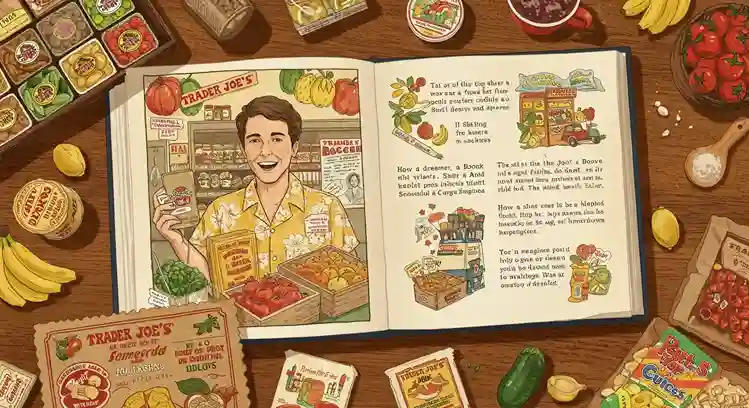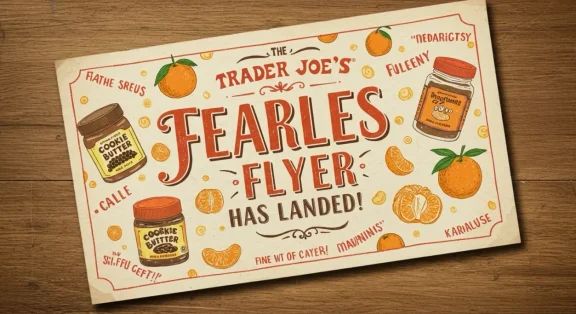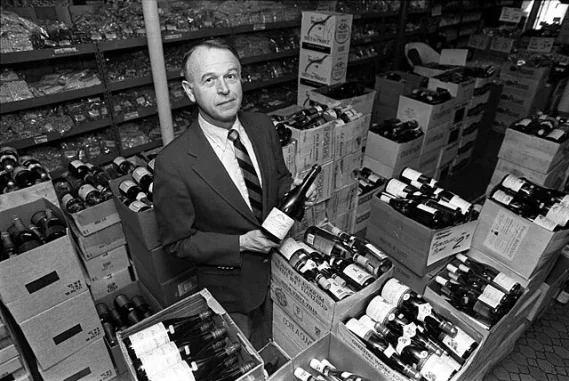Trader Joe’s Brand Story : The Journey Behind the Beloved Grocery Chain
By Kushal Shrestha - Mar 23, 2025 | Updated: March 23, 2025 | 13 min read

Aren’t you excited to read about the enjoyable Trader Joe’s Brand Journey and discover the individual who influenced the brand’s name? Walking into a Trader Joe’s store, visitors can expect a magical experience because every aisle holds exotic goods with exciting international origins and proficient employees who treat customers with friendly, guide-like service. Customers discover an unforgettable grocery shopping experience at Trader Joe’s, where the ordinary transforms into magic.
Trade Joe’s functions more as an ordinary grocery location since it is an affordable adventure hub. Each visit to Trader Joe’s creates an international food adventure within the store.
Joseph Coulombe founded Trader Joe’s in 1967 following consumer shopping guidance that he formulated. The idea existed through his understanding that customers needed a new shopping discovery at every stop.
Trader Joe’s distinguishes itself through its dedication to high standards, unique product selection system, and honest care for its customer base. When he founded the store, Coulombe created his vision based on a shop that served brilliant and worldly patrons by providing premium yet affordable international merchandise.
The original vision conceived by Coulombe has grown into what today makes Trader Joe’s beloved throughout America.
The store has become a leading shopping destination because it offers consumers unique options. It’s the story of how this famous brand measures up to the entertaining story of its products.
Trader Joe’s brand journey and expansion reveal how innovation, market understanding, and adaptability allowed the brand to develop from its initial start to its rapid growth in modern times.
Trader Joe’s operates 597 stores across America to serve customers who prefer to purchase upscale products at reasonable prices daily.
Let’s look at the history behind Trader Joe’s brand journey!
The Tale of Trader Joe’s Brand Journey: How a Dreamer, a Book, and a Hawaiian Shirt Built a Grocery Empire

The Dreamer
During the sunny 1950s in Los Angeles, Joe Coulombe launched his business dream, which would come to life through Pronto Markets convenience stores. Los Angeles residents at high speed would find quick food and necessary items through his business vision.
Joe experienced mounting business competition in the middle of the 1960s. The expanding dominance of giants like 7-Eleven forced his hand when he realized that price and size competencies would not let him survive. His store disappeared along with the passing highway billboards.
The Book
Joe, who earned his MBA from Stanford, maintained an active mental state and refused to quit in life. He devoted many dark hours to reading multiple books and travel accounts with a motive to gain inspiration.
That evening, he accidentally discovered White Shadows in the South Seas, written by Frederick O’Brien. The book depicted tropical traders engaging in commercial activity, exchanging spices and silks and fascinating tales from distant islands.
During that period, he stumbled into Trader Vic’s restaurant, which presented a tropical-themed atmosphere with bamboo decor swaying and rum flowing as customers enjoyed being adventurers in a Polynesian paradise.
Something clicked.
In his vision, Joe envisioned a neighborhood market delivering more than just bread and milk since it would access various global flavors.
Such a place would let teachers and students with inquisitive minds experience unique tastes in a wallet-friendly manner. He scribbled notes: “What if we make people feel like they’re discovering treasures?”
He made a complete business investment in his 1967 strategic plan to complete the Trader Joe’s brand journey. He converted Pronto Markets into the inaugural Trader Joe’s by removing it from operation to establish the first branch in Pasadena, California. The business name at its inception was drawn from Trader Vic’s and the exotic “trader” character depicted in O’Brien’s book, but it added a distinctive element to it. Joe personalized this mission by including the title “Joe” in the store’s name.
The operation represented his venture as a corporate entity that played a host role with customers as his passengers.
The Hawaiian Shirt
Many remarkable features filled the store. The employees wore Hawaiian shirts, rang sales bells, and displayed their private-label Tahitian vanilla and Argentinean chimichurri products on crowded shelves. The revolutionary aspect of his business model involved eliminating conventional distribution channels. Neighborhood Market customers benefitted from his direct purchasing model, which cut costs and allowed for products unique to Trader Joe’s.
Joe purchased all of the Chilean wine from the market release and created Trader Joe’s versions, which he offered at bargain prices to customers.
Building the Empire
The first months were challenging. Every grocery chain in Joe’s territory launched negative advertising to make fun of his “hippie market” before predicting it would fail during its first operating year. Through his visionary outlook, Joe never faltered in trusting the business plan.
The owner dedicated extensive time to socializing with customers to recognize the gaps in their existing requirements. He devoted his days to traveling throughout the city in pursuit of active manufacturers who produced high-quality goods at cost-effective rates.
Because of its exclusive products, the store gained recognition among college professors, travel writers, and food enthusiasts. People who enjoy cooking and spice exploration find the market their central meeting point.
Through his personable approach, Joe interacted with all his customers individually to offer tastings followed by informative talks about where each product came from, resulting in a loyal customer base.
Innovation and Expansion
Trader Joe’s reached its most significant brand milestone when Joe sold the company to German billionaire Theo Albrecht, co-founder of Aldi Nord, in 1979. The company succeeded in nationwide expansion by preserving its genuine foundations. The Trader Joe’s brand journey now consists of more than 500 stores that stay faithful to Joe’s original belief that shopping for groceries should bring joy instead of difficulties.
Legacy of Trader Joe’s Brand Journey
Trader Joe’s stores under Joe Coulombe’s leadership have demonstrated the successful implementation of his original plan to redecorate grocery shopping as an enthusiastically stimulating process. A Caribbean vacation fantasy dreamed up by Joe Coulombe developed into hundreds of nationwide stores that preserve the original spirit of the shopping experience.
Today, Trader Joe’s brand maintains its initial appeal of distant overseas exploration and exotic delicacies, thus affirming that incredible commercial breakthroughs occasionally manifest from unusual origins, which he discovered on his tropical beach hammock.
The evolution of Trader Joe’s represents one individual’s mission to transport travel excitement into daily food shopping, which continues to drive its retail success. Strategic thinking, deep consumer insight, and constant innovation have allowed Joe Coulombe to develop a grocery business that still engages customers at millions of stores.
The Fearless Flyer: A Grocery Store’s Unexpected Love Letter to Its Customers

During Trader Joe’s early stages in 1969, the Pasadena store distributed an “Insider’s Report” to train its growing wine selection personnel. Joe Coulombe understood his employees’ required insights into Bordeaux wine from France, Chianti from Italy, and wine produced in California as they sold these varieties to customers.
Customers quickly found the newsletter because they appreciated its friendly explanations. In the early 1980s, the company newsletter added food products and recipes, which became fundamental to Trader Joe’s brand journey.
The establishment of “Fearless Flyer” in 1985 represented a significant branding advancement for the Trader Joe’s brand journey. The store adopted “Fearless Flyer” as its new name because it manifested its pioneering spirit and dedication to lead customers through specialty food and wine selections. Through its expansion, the Flyer added witty essays and cultural articles about foreign foods, and it provided customers with exclusive behind-the-scenes views of Trader Joe’s product sourcing procedures.
Throughout its national expansion, the Fearless Flyer emerged as a standard marketing tool and a beloved customer asset at Trader Joe’s. Through its Fearless Flyer publication, the company brought “Two-Buck Chuck” and international snack items to shoppers who appreciated its signature communication style.
Digital marketing has changed retail, but Fearless Flyer continues to find value in this area. The Trader Joe’s brand journey uses its digital presence to enhance the sensory experience people get from reading their printed Fearless Flyer. An essential internal document has transformed into an established community institution that links the company to its members through educational experiences and culinary pleasure.
READ MORE: Airbnb brand evolution: How It Redefined Travel and Hospitality?
Trader Joe’s Brand Journey: How Alcohol Sales Built the Foundation for a Grocery Empire

Joe Coulombe established the first Trader Joe’s store in Pasadena, California, in 1967 through a distinctive idea to create an atmosphere resembling an adventurer’s sanctuary with the world’s most extensive alcoholic beverages collection. Every shelf at the store contained 100 Scotch brands, 70 bourbon brands, 17 California wine options, 50 kinds of gin, and 14 different types of tequila. The store featured nautical decorations while Hawaiian music emitted from its speakers to produce an exclusive ambiance. The establishment marked the inaugural step in the Trader Joe’s brand journey through a retail innovation that would eventually reshape how Americans shopped.
Joe discovered that educated and well-traveled customers did not wish to buy standard convenience store items. They sought premium alcohol products and exclusive merchandise. To attract these specialty buyers, he established a marketplace that combined Hawaiian design elements with custom products while other stores appeared essential.
In 1970, a French wine importer exposed an unintended section of California alcohol price regulations to Joe. Joe obtained Bordeaux wines from his partner at wholesale prices to offer outstanding deals on luxury wineries at his retail store. The company gained national recognition for providing top-quality wines at competitive prices.
In the late 1970s, Joe encountered his most significant challenge when California abolished Fair Trade laws. The rejection of withdrawal led him to concentrate on exclusive private-label products and novel items. After moving past alcohol sales, he expanded his business with international food items, health products, and specific grocery goods that addressed the needs of his college-educated customers.
Joe recognized that his customers desired more than alcohol purchases, so he created a shopping environment focused on discovery and superb products. Combining this pivotal customer understanding allowed the brand to transition from a liquor store into a multi-location grocery chain with over 500 locations serving customers nationwide.
Today, Trader Joe’s is a success story that demonstrates the combination of Joe Coulombe’s strategic thinking with his spirit of persistence and entrepreneurial mindset. A single retail store specializing in alcohol sales has evolved into a respected grocery empire because its founder trusted his brand identity while taking strategic gambles.
Trader Joe’s Logo: Meaning and History

Through its lasting popularity, the logo demonstrates how well it represents Trader Joe’s expansion from a single store to become the retail giant it currently is. The Trader Joe’s logo demonstrates successful branding consistency that reaches consumers of all generations to showcase how simple designs can convey the most profound messages. Fred Schroeder became his design choice because the designer had previously designed Marie Callender’s restaurant signage.
When Schroeder started his work, he created the recognizable retail logo. Inspired by tiki culture and nautical elements adapted to match the coastal spirit of California and the brand’s international buying practices, he designed the recognizable trademark “Trader Joe’s” that launched the Trader Joe’s brand journey.
The selection of red for the logo design was no accident. The red color scheme represents festive shopping energy while emitting excitement and providing the celebratory atmosphere that Trader Joe’s wants to give customers through an exceptional alternative to supermarkets. The black design elements in the logo enabled a sophisticated contrast that communicated future elements of Trader Joe’s brand quality and reliability standards.
The font’s design sends messages about exploration. For the logo, Schroeder created an original typeface featuring playful and slightly mismatched elements, which generate a feeling of exploration. The forward-looking text stands out because of its bold size and decorative elements that create visual appeal. The logo’s unique design enables quick recognition, keeping the brand visible among numerous merchants in the market.
Trader Joe’s brand journey has experienced minimal changes because the company has maintained a timeless identity and brand relevance. The company’s dedication to traditional design has made its logo a trusted sign for customers who want affordable premium groceries with international elements.
Through its lasting popularity, the logo demonstrates how well it represents Trader Joe’s brand journey from a single store to becoming its current retail giant. The Trader Joe’s logo demonstrates successful branding consistency that reaches consumers of all generations to showcase how simple designs can convey the most profound messages.
The Story of Trader Joe’s Brand Values
Trader Joe’s serves as more than a standard grocery outlet because its lasting brand values attract existing customers to its unique marketplace. The company strives to provide high-quality, affordable products for adventurous customers. The shopping principles valued by Joe Coulombe during Trader Joe’s founding phase remain the brand’s core identity in the current market.
The Foundation of Values
- Quality & Affordability: Direct sourcing and private labeling undoubtedly allow companies to set competitive prices on goods without sacrificing overall product quality.
- Community Connection: Customers seek an environment that their neighborhood market.
- Exceptional Customer Experience: Friendly staff, a fun atmosphere, and a neighborhood-store feel.
- Sustainability & Ethics: The store uses decreased packaging techniques while choosing sustainable seafood sources with fair trade standards.
- Transparent Pricing: Everyday low prices with no gimmicks, sales, or loyalty programs.
Trader Joe’s commitment to maintaining its core values has helped create devoted customers who distinguish it in the grocery sector.
The Mission Takes Shape
The official mission statement developed naturally from these established principles: “To provide quality food products at the lowest possible prices.” The statement embodied Trader Joe’s straight-talking fundamental principles, which appeared directly from their core values.
Trader Joe’s Historical Milestones: A Timeline of Growth and Innovation
- Joe Coulombe founded Pronto Markets in California in the early 1960s.
- The first Trader Joe’s store opened in Pasadena, California, in 1967, with a unique tiki theme.
- Later in the 1970s, the began creating in-house brand products, such as granola, orange juice, vitamins, nuts, and cheeses.
- 1979: Acquired by the Albrecht family/Aldi.
- 1988: John Shields becomes CEO.
- 1993: Expands beyond California to Arizona.
- 1996: Makes East Coast debut in Boston.
- 2002: Introduces “Two-Buck Chuck” wine at $1.99 per bottle.
- 2008: Launches first website.
- 2012: Reaches 400 stores nationwide.
- 2018: Introduces delivery service in select markets.
- 2023: Operates over 590 stores across 43 states.
Conclusion: Trader Joe’s Enduring Legacy
The Trader Joe’s brand journey was formed by its vision to build a unique grocery venture that combined exploration with budget-friendly prices. Since its Pasadena start, the Journey has developed into a world-famous landmark while embracing innovation, prioritizing customer needs, and defying conventional industry practices.
A single Tiki-themed store with Hawaiian-shirted retail staff has developed into a retail blockbuster that defines modern American grocery shopping. The company maintains its distinctive character as it grows nationwide, proving how organizational focus on mission and values combined with relevant changes can result in successful expansion.
The future that Trader Joe’s is looking into still lies in the spiritfulness of thought and open customer relationships that can continuously foster brand loyalty.
The Trader Joe’s Brand Journey is not just about distributing anything; it’s about forming the necessary encounters that move the buyer from an everyday activity to a magical quest, a worthwhile journey that should extend into future years.
Notice an error?
Help us improve by submitting a correction.







